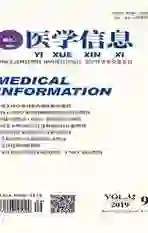β受体阻滞剂治疗婴幼儿血管瘤的研究进展
2019-06-10赖子梅王珊
赖子梅 王珊
摘要:婴幼儿血管瘤(IH)是婴幼儿期最常见的良性肿瘤,大部分病变可自然消退,多以随访观察为主,但对可引起严重并发症或功能障碍的中、高风险IH仍主张尽早干预及治疗。普萘洛尔为非选择性β受体阻滞剂,自2008年开始应用于IH治疗后经大量临床实验及系列研究疗效得到验证,目前已成为IH治疗的一线药物。随着人们对IH认识的进一步深入及普萘洛尔相关治疗机制的探索,近年来其他β受体阻滞剂类药物治疗IH的报道逐渐增多,其在IH的应用范围逐渐扩大,药物选择相应增多。本文简要综述目前β受体阻滞剂应用于IH治疗的相关进展,进一步探究其疗效及安全性,为IH临床治疗提供更多选择及参考依据。
关键词:婴幼儿血管瘤;β受体阻滞剂;普萘洛尔
中图分类号:R732.2 文献标识码:A DOI:10.3969/j.issn.1006-1959.2019.09.018
文章编号:1006-1959(2019)09-0054-04
Abstract:Infantile hemangioma (IH) is the most common benign tumor in infants and young children. Most of the lesions can be resolved naturally. Most of them are followed up, but the medium and high risk IH can cause serious complications or dysfunction. Advocate early intervention and treatment. Propranolol is a non-selective beta blocker. It has been proven in clinical trials and series of studies since IH was applied in 2008. It has become the first-line drug for IH treatment. With the further understanding of IH and the exploration of propranolol-related therapeutic mechanisms, reports of other β-blockers in the treatment of IH have increased in recent years, and their application in IH has gradually expanded. increase. This article briefly reviews the current progress of β-blockers in the treatment of IH, further explores its efficacy and safety, and provides more options and reference for clinical treatment of IH.
Key words:Infantile hemangiomas;β-blockers;Propranolol
婴幼儿血管瘤(infantile hemangiomas,IH)为血管内皮细胞异常增殖性病变,是儿童最常见的良性血管性肿瘤,发病率3%~10%。IH发病机制至今尚未完全阐明,大部分研究认为其与血管生成关系密切[1]。因IH具有自然消退特性,多数主张对位于非特殊部位且无严重并发症的病变采取观察随访,但对可引起功能障碍、毁容、瘢痕或溃疡形成等中高风险病变仍需积极干预及治疗[2]。既往糖皮质激素口服是IH首选治疗方案,但疗效个体差异较大,且严重不良事件发生率较高。手术切除有效率虽高但存在完整切除困难、术后易复发等问题。介入治疗因其较传统手术创伤小且療效显著近年来逐渐成为辅助治疗[3]。2008年,Leaute-Labreze首次报道了口服普萘洛尔应用于IH取得良好疗效,此后普萘洛尔逐渐在临床推广及大量应用,尽管其可能引起低血压、心动过缓、低血糖和支气管痉挛等严重不良反应,但大量文献报道证实上述不良反应发生率相对较低,且经严格规范监控及管理可得到有效防范[4,5]。故与糖皮质激素及其他治疗方式相比,普萘洛尔系统性用药治疗IH疗效显著,且安全性和耐受性更高,逐渐成为IH的一线治疗药物。随着对IH病因、病理生理学特点、病变发展等认识的进一步深入及普萘洛尔相关治疗机制的研究,β受体阻滞剂在IH的应用逐渐扩大,近年来亦有阿替洛尔、纳多洛尔等其他β受体阻滞剂用于IH治疗获得满意疗效的研究报道。结合近年相关文献资料,本文综述了β受体阻滞剂类药物治疗IH的最新进展。
1婴幼儿血管瘤的发病特点及病程进展
婴幼儿血管瘤新生儿期患病率约为4%~5%,以女性、白种人居多,其中女性患病率约为男性的2.3~2.9倍[6]。其发病相关因素包括:出生体重、胎龄、血管瘤家族史、宫内并发症如子痫、胎盘异常等,相关研究发现IH发病率随着出生体重和胎龄的减少而增加,尤其在体重<1000 g的早产儿中发病率高达23%[6,7]。IH的自然病程在足月儿和早产儿中无明显差异,均可分为增殖期、消退期及消退完成期[8]。其前体病变均为出生时即存在,部分在新生儿早期就表现出血管收缩的苍白区域或毛细血管扩张的红色斑疹。通常在生后1~3周后开始增生,在5~8周生长速度达到峰值,约80%的瘤体在前3个月内可快速形成[9]。在经历一段时间的稳定期后病变开始逐渐消退,约90%的病例在5岁前可完全消退,对于面积较大或较深的病变,可能持续到7岁或8岁。IH消退后仍有50%~70%因残留病灶中局部毛细血管扩张、纤维脂肪组织过度增生以及弹性组织破坏等将导致局部皮肤松弛、瘢痕形成或萎缩等后遗症[10]。病程中亦有10%~15%的IH可引起出血、感染、溃疡、瘢痕、毁容、功能障碍等不同程度的并发症需积极临床干预并尽早治疗[11]。
2 β受体阻滞剂治疗婴幼儿血管瘤的作用机制
尽管因普萘洛尔治疗IH的效果显著,其作用机制也受到广泛关注及研究,但目前尚不完全清楚,相关报道发现可能与快速的血管收缩、抑制血管新生、诱导细胞凋亡、肾素分泌减少等机制有关[12,13]。另有研究发现普萘洛尔可通过PI3K、AKT、HIF-1α、FLT1/2、VEGF、VEGF A、FOXF1等相关细胞因子、蛋白或通路作用抑制血管肿瘤细胞再生及诱导细胞凋亡[14-16]。Wei L等[17]亦通过对人脐静脉内皮细胞(human umbilical vein endothelial cells,HUVECs)的研究进一步证实,普萘洛尔具有抑制细胞增殖、促进细胞凋亡的作用。而其他类型β受体阻滞剂应用于IH治疗的相关作用机制则尚未见报道。
3 β受体阻滞剂应用于IH治疗的疗效及安全性比较
3.1普萘洛尔 普萘洛尔为目前IH治疗的首选药物,是非选择性β受体阻滞剂,其推荐使用的目标剂量为1~3 mg/(kg·d),目前广泛接受的治疗剂量为2 mg/(kg·d),有效率在60%~97%,达到稳定疗效的治疗时间多在6个月以上[18,19]。盐酸普萘洛尔口服液(Hemangeol)经食品及药物管理局(Food and Drug Administration,FDA)批准用于IH增殖期的治疗,其浓度为4.28 mg/ml,推荐剂量为3.4 mg/(kg·d),分2次服用[20]。治疗期间报道不良事件包括无症状低血糖、低血压和低心率,支气管痉挛,气喘、一过性呼吸困难、喘鸣、睡眠障碍、失眠、嗜睡、多汗,胃食管返流,胃肠道症状(恶心、呕吐、腹泻),轻度的肝功能损害,过敏性皮疹,增加感染性疾病发病率等[21,22]。由于大多数心动过缓和低血压发作发生在治疗开始或剂量增加期间,因此低起始剂量是更为安全的方法,在首次服药、药物剂量增加和达到目标剂量后均需于服药后1 h和2 h,分别测量心率、血压、呼吸、血糖等基础指标,对结果异常者需连续监测至达正常范围[23]。现有的指南认为门诊使用普萘洛尔是安全有效的,但对于纠正胎龄8周的婴儿、一般状况差、需要维持血糖、以及合并心血管或呼吸系统疾病的婴儿,应当住院监测[24]。此外,普萘洛尔作为一种亲脂性非选择性β1、β2受体阻滞剂,可以穿过血脑屏障,其对婴幼儿中枢神经系统是否具有潜在的长期有害影响(如睡眠障碍和未来的记忆缺陷等),目前尚不清楚。
3.2阿替洛尔 阿替洛尔为亲水性选择性β受体阻滞剂,主要拮抗β1受体,不会跨越血脑屏障,理论上消除了对中枢神经系统潜在影响风险。多项研究对阿替洛尔及普萘洛尔治疗IH的疗效进行比较发现两者疗效相近,但阿替洛尔副反应发生率更低,提示普萘洛尔β2受体拮抗作用可能与其副反应相关而与IH疗效关系不显著。因此,阿替洛尔选择性拮抗β1受体的特性在保证疗效的基础上,更可进一步降低由β2受体拮抗作用引起的支气管痉挛等不良反应的发生率,使其在合并有哮喘等呼吸系统疾病的IH治疗中较普萘洛尔安全性更高[25,26]。在Abarzua-Araya A等和de Graaf M等的口服普萘洛尔和阿替洛尔治疗IH的临床对照试验中,使用药物剂量分别为 1 mg/(kg·d)和 1~3 mg/(kg·d),结果证实两者疗效亦无显著差异,但与普萘洛尔相比,较低剂量和低频次的阿替洛尔(1次/d)能够显著提高患者的依从性[27,28]。
3.3纳多洛尔 纳多洛尔是一种亲水性非选择性β受体阻滞剂,与阿替洛尔相似,亦不能通过血脑屏障,故夜惊、梦魇等相关睡眠障碍的发生率低,与普萘洛尔相比,纳多洛尔心肌抑制活性更低且半衰期更长(12~24 h),血药浓度更为稳定,可有效抑制病灶的复发生长,并减少服药频率增加依从性[29,30]。Pope E等在一项涉及19例头颈部IH患者治疗的队列研究中,比较纳多洛尔[剂量为1~4 mg/(kg·d),分2次口服]和普萘洛尔[2~3 mg/(kg·d),分3次口服]的疗效差异,治疗时间达6个月。结果显示与普萘洛尔相比,纳多洛尔对IH疗效更好、起效更快,且经纳多洛尔治疗的IH复发率更低。在纳多洛尔治疗期间报告的不良事件包括低体温、胃肠道症状、睡眠障碍和寒冷引起的喘息,此外亦有部分出现心率减慢现象[31]。上述研究表明纳多洛尔治疗IH较普萘洛尔疗效更佳、且疗程更短,在增殖期IH患者中疗效更显著,但其疗效及安全性目前尚缺少更为可靠的大量随機对照试验来证实。
3.4噻吗洛尔 噻吗洛尔(替莫洛尔)为β肾上腺能受体拮抗剂,作用强度较普萘洛尔更高,但无选择性及膜稳定作用,无抑制心肌作用和内源拟交感活性,其局部应用于病变表浅的小病灶IH能够有效降低与系统性治疗相关的不良事件的风险。Chan H等[32]采用0.1%的噻吗洛尔治疗病变表浅的小病灶IH,在第12和16周时,噻吗洛尔组和安慰剂组的病灶大小仅有微小的差异,但噻吗洛尔组的IH稍小。在8周、20周和24周时,噻吗洛尔治疗的患者病灶显著减小。Chakkittakandiyil A和Chambers CB分别使用0.5%和0.25%的噻吗洛尔溶液局部外用,均取得了满意的疗效[33,34];Chakkittakandiyil A还指出,噻吗洛尔外用对于较浅的IH疗效更加满意,上述研究报道中,仅1例患者出现睡眠障碍的不良事件[33]。故对于表浅型尤其是病变较小或局限的IH,局部噻吗洛尔外用是口服普萘洛尔的良好替代治疗,可以作为辅助药物,以缩短口服治疗的时间和防止复发,对于有口服普萘洛尔禁忌证的患者亦可耐受。Wu HW等[35]通过对724例表浅型IH经噻吗洛尔与普萘洛尔的对照治疗研究发现两者疗效无明显差异,考虑到疗效显著并可提高安全性等优势,故推荐局部外用噻吗洛尔作为表浅型IH的一线治疗药物。
4总结与展望
普萘洛尔作为IH治疗使用最早且最广泛的β受体阻滞剂,其较糖皮质激素及其他治疗的有效性和安全性更高这一观点已被广泛认同,近年来研究报道显示其他多种β受体阻滞剂亦逐渐用于IH的治疗并取得良好疗效,其中选择性β受体阻滞剂理论上可减少普萘洛尔相关不良反应发生率,因而具有更高的安全性,但目前仍缺少大量临床随机对照试验和相关研究来进一步证实,其安全性和有效性尚缺乏亦更为可靠的证据,故目前普萘洛尔的一线治疗药物地位尚未被取代。随着其他β受体阻滞剂类药物的使用及推广、相关治疗机制及药物安全性及有效性的进一步深入研究,未来IH的治疗或许将会出现新的转变。
參考文献:
[1]Soliman YS,Khachemoune A.Infantile hemangiomas:our current understanding and treatment options[J].Dermatol Online J,2018,24(9).
[2]Strumila A,Dagilyte RV,Virgilijus Beisa,et al.Recommendations and a guideline for referral of infantile haemangioma to tertiary centres[J].Acta Med Litu,2018,25(1):38-44.
[3]Puttgen KB.Diagnosis and management of infantile hemangiomas[J].Pediatr Clin North Am,2014,61(2):383-402.
[4]Drolet BA,Frommelt PC,Chamlin SL,et al.Initiation and use of propranolol for infantile hemangioma:report of a consensus conference[J].Pediatrics 2013,131(1):128-140.
[5]Babiak-Choroszczak L,Gizewska-Kacprzak K,Dawid G,et al.Safety assessment during initiation and maintenance of propranolol therapy for infantile hemangiomas[J].Adv Clin Exp Medicine,2019.
[6]Munden A,Butschek R,Tom WL,et al.Prospective study of infantile haemangiomas:incidence, clinical characteristics and association with placental anomalies[J].Br J Dermatol,2014,170(4): 907-913.
[7]Goelz R,Poets CF.Incidence and treatment of infantile haemangioma in preterm infants[J].Arch Dis Child Fetal Neonatal Ed,2015,100(1):F85-F91.
[8]Castren E,Salminen P,Vikkula M,et al.Inheritance patterns of infantile hemangioma[J].Pediatrics,2016,138(5):e20161623.
[9]Darrow DH,Greene AK,Mancini AJ,et al.Diagnosis and management of infantile hemangioma[J].Pediatrics,2015,136(4):e1060-e1104.
[10]Dompmartin A.Classification of vascular anomalies[J].Ann Dermatol Venereol,2013,140(5):337-339.
[11]Rotter A,de Oliveira ZNP.Infantile hemangioma: pathogenesis and mechanisms of action of propranolol[J].J Dtsch Dermatol Ges,2017,15(12):1185-1190.
[12]Ji Y,Chen S,Xu C,et al.The use of propranolol in the treatment of infantile haemangiomas: an update on potential mechanisms of action[J].Br J Dermatol,2015,172(1):24-32.
[13]Hagen R,Ghareeb E,Jalali O.Infantile hemangiomas:what have we learned from propranolol?[J].Current Opinion in Pediatrics,2018,30(4):499-504.
[14]Lin Z,Wang L,Huang G,et al.Propranolol inhibits the activity of PI3K,AKT,and HIF-1α in infantile hemangiomas[J].Pediatric Surgery International,2018,34(11):1233-1238.
[15]Sun B,Dong C,Lei H,et al.Propranolol inhibits proliferation and invasion of hemangioma-derived endothelial cells by suppressing the DLL4/Notch1/Akt pathway[J].Chem Biol Interact,2018(294):28-33.
[16]Zhao F,Yang X,Xu G,et al.Propranolol suppresses HUVEC viability, migration,VEGF expression, and promotes apoptosis by downregulation of miR-4295[J].J Cell Biochem,2019,120(4): 6614-6623.
[17]Wei L,Li L,Zhang B.Propranolol Suppresses Cobalt Chloride-Induced Hypoxic Proliferation in Human Umbilical Vein Endothelial Cells in vitro[J].Pharmacology,2018,103(1-2):61-67.
[18]Del Frari L,Léauté-Labrèze C,Guibaud L,et al.Propranolol pharmacokinetics in infants treated for Infantile Hemangiomas requiring systemic therapy: Modeling and dosing regimen recommendations[J].Pharmacology Research & Perspectives,2018,6(3):e00399.
[19]Drolet BA,Frommelt PC,Chamlin SL,et al.Initiation and use of propranolol for infantile hemangioma:report of a consensus conference[J].Pediatrics,2013,131(1):128-140.
[20]Zhou W,He S,Yang Y,et al.Formulation,characterization and clinical evaluation of propranolol hydrochloride gel for transdermal treatment of superficial infantile hemangioma[J].Drug DevelOpment and Industrial Pharmacy,2015,41(7):1109-1119.
[21]Léauté-Labrèze C,Hoeger P,Mazereeuw-Hautier J,et al.A randomized, controlled trial of oral propranolol in infantile hemangioma[J].The New England Journal of Medicine,2015,372(8):735-746.
[22]Saqi L,Zvulunov A,Lapidoth M,et al.Efficacy and safety of propranolol for the treatment of infantile hemangioma: a presentation of ninety-nine cases[J].Dermatology,2014,228(2):136-144.
[23]Chang L,Ye X,Qiu Y,et al.Is Propranolol Safe and Effective for Outpatient Use for Infantile Hemangioma? A Prospective Study of 679 Cases From One Center in China[J].Annals of plastic surgery,2016,76(5):559-563.
[24]Hoeger PH,Harper JI,Baselga E,et al.Treatment of infantile haemangiomas:recommendations of a Accepted Article This article is protected by copyright[J].Eur J Pediatr,2015,174(4):855-865.
[25]Bayart CB,Tamburro JE,Vidimos AT,et al.Atenolol Versus Propranolol for Treatment of Infantile Hemangiomas During the Proliferative Phase:A Retrospective Noninferiority Study[J].Pediatric Dermatology,2017,34(4):413-421.
[26]Wang Q,Xiang B,Chen S,et al.Efficacy and safety of oral atenolol for the treatment of infantile haemangioma: A systematic review[J].Australas J Dermatol,2018.
[27]Abarzúa-Araya A,Navarrete-Dechent CP,Heusser F,et al.Atenolol versus propranolol for the treatment of infantile hemangiomas:A randomized controlled study[J].J Am Acad Dermatol,2014,70(6):1045-1049.
[28]de Graaf M,Raphael MF,Breugem CC,et al.Treatment of infantile haemangiomas with atenolol: Comparison with a historical propranolol group[J]. J Plast Reconstr Aesthet Surg,2013,66(12):1732-1740.
[29]Randhawa HK,Sibbald C,Garcia Romero MT.Oral Nadolol for the Treatment of Infantile Hemangiomas: A Single-Institution Retrospective Cohort Study[J].Pediatric Dermatology, 2015,32(5):690-695.
[30]Bernabeu-Wittel J,Narváez-Moreno B,de la Torre-García JM,et al.Oral Nadolol for Children with Infantile Hemangiomas and Sleep Disturbances with Oral Propranolol[J].Pediatric dermatology,2015,32(6):853-857.
[31]Pope E,Chakkittakandiyil A,Lara-Corrales I,et al.Expanding the therapeutic repertoire of infantile haemangiomas: Cohort-blinded study of oral nadolol compared with propranolol[J].Br J Dermatol,2013,168(1):222-224.
[32]Chan H,McKay C,Adams S,et al.RCT of timolol maleate gel for superficial Infantile hemangiomas in 5- to 24-weekolds[J].Pediatrics,2013,131(6):e1739-e1747.
[33]Chakkittakandiyil A,Phillips R,Frieden IJ,et al.Timolol maleate 0.5% or 0.1% gel-forming solution for infantile hemangiomas: A retrospective, multicenter, cohort study[J].Pediatr Dermatol,2012,29(1):28-31.
[34]Chambers CB,Katowitz WR,Katowitz JA,et al.A controlled study of topical 0.25% timolol maleate gel for the treatment of cutaneous infantile capillary hemangiomas[J].Ophthal Plast Reconstr Surg,2012,28(2):103-106.
[35]Wu HW,Wang X,Zhang L,et al.Topical Timolol Vs Oral Propranolol for the Treatment of Superficial Infantile Hemangiomas[J].Frontiers in Oncology,2018(8):605.
收稿日期:2019-1-7;修回日期:2019-2-13
編辑/肖婷婷
作者简介:赖子梅(1994.5-),女,江西瑞金人,硕士研究生,主要从事儿童肿瘤性疾病方向的研究
通讯作者:王珊(1963.3-),女,天津人,博士,主任医师,教授,主要从事儿童良恶性实体肿瘤方向的研究
